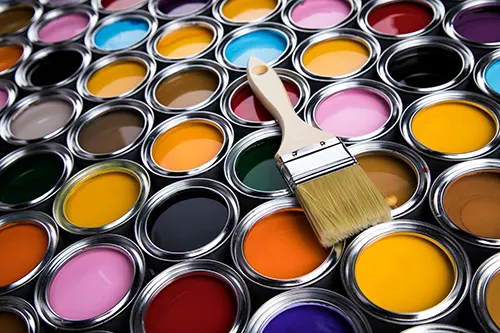24 March 2025

A modern fireplace in a contemporary, white-walled room with a TV above the fireplace.
Choosing the right products is crucial for a successful fireplace transformation. A stain blocking primer helps prevent future soot stains and helps the paint adhere to the brick. This keeps it looking great for longer. Paint choice is also a key decision when revamping your fireplace. Consider the finish you want and how much maintenance you’re willing to take on, which may also depend on whether it’s an indoor or outdoor fireplace.
Latex paint is a popular water-based choice for brick fireplaces because it requires little maintenance and is straightforward. It adheres well to brick surfaces, comes in various finishes, and can be used indoors and outdoors.
If your aim is practicality, latex paint is known for its quick drying time and easy cleanup, making it suitable for indoor projects. It also tends to be less expensive than acrylic paint.
Healthwise, latex paint releases less fumes than acrylic paint but requires proper ventilation while painting and drying. Check out this list of standards approved by the Environmental Protection Agency when shopping for interior latex paint.
Acrylic paint is durable and resists chipping, peeling, cracking, and fading. However, it contains harsh chemicals that emit harmful fumes as it dries, so proper ventilation and protective gear are necessary when applying it indoors.
This type of paint is better for exterior brick fireplaces because it can handle temperature fluctuations. It forms a weather-resistant layer that shields the brick from rain and winter conditions. Both acrylic and latex paints offer various finish options, including flat/matte, satin, semi-gloss, and high-gloss.
Chalk paint has gained popularity for its matte finish and vintage look. It’s a good choice if you’re aiming for a rustic or shabby-chic look for either an interior or exterior fireplace.
Chalk paint preserves the original fireplace color under a thin, chalk-like layer. This technique eliminates the need for primer.
If you plan on painting the firebox, you’ll need heat-resistant paint. This type of paint can handle temperatures upward of 750 degrees Fahrenheit without degrading, discoloring, or emitting fumes.
Specifically designed for brick and masonry surfaces, masonry paint is durable and weather resistant. It’s ideal for outdoor fireplaces or those exposed to moisture and changing weather conditions.
If you want to retain the natural texture of the brick while changing its color, consider using a brick stain. Staining penetrates the brick’s surface, allowing its texture to show through while altering its hue rather than coating it.
Whitewashing is a technique that involves diluting the paint with water to create a translucent finish. It’s a best-of-both-worlds option that lets some original brick color show through. It’s also budget-friendly; you can whitewash a brick fireplace for less than $40 for both indoor and outdoor brick fireplaces.
Limewash paint is made by mixing water, pigment, and crushed limestone. Known for its clay-like texture, it conveys a nonreflective, vintage look. Limewash paint is low maintenance and will not peel or chip over time. Limewash formulas are nontoxic, environmentally friendly, breathable, and resistant to mold. Luckily, if you’re unhappy with it, limewash is removable for up to five days after application.
For help choosing paint, contact Monnick Supply, your local hardware store.
Source: houselogic.com